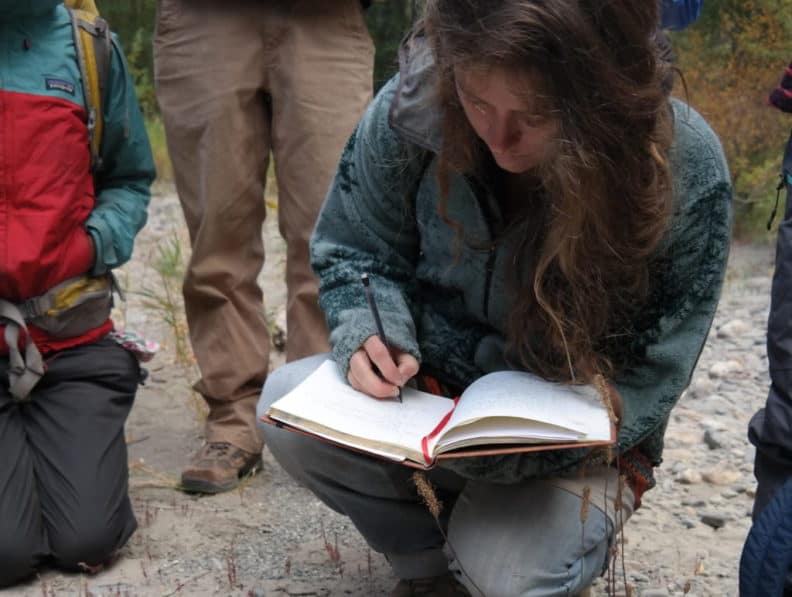
Natural History Field-Excursion: A Grinnell Journal Entry for a Day with David Moskowitz
This post is the third of a 3-part series describing graduate students’ ten-day field excursion to the Methow Valley, as part of their fall Natural History Course. Click here for all three parts.
On October 6, 2017, the 17th cohort of graduate students ended their 10-day field course by meeting with wildlife tracker and photographer, David Moskowitz, to learn more about tracking. This blog post was written in the Grinnell Method of keeping a naturalist journal by graduate student Liz Grewal.
06 October 2017
Left Skalitude resort at 806, 36°F Sparse, cirrus clouds were observed.
Skalitude Retreat Center, Okanongan County, Washington
Route: Leaving Skalitude Retreat Center, 2.1 mi on Smith Canyon Road, 3.7 mi on Libby Creek
Road, 9.3 mi on SR 153 North, 2.3 mi on SR 20 West. Detour to Cinnamon Twisp for coffee and pastries: right on to E 2nd Ave, left North Glover St. Continue on SR 20 West for 16.9 miles, pull off on left side of highway, just downstream from Weiman Bridge.
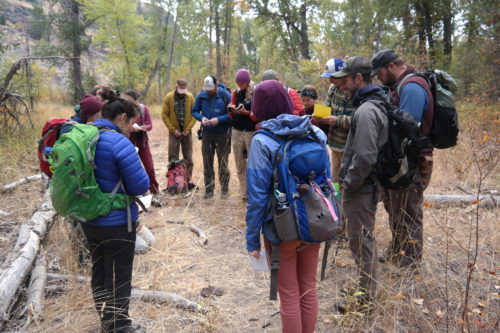
9:40 We met with David Moskowitz for introductions. D. Moskowitz has over 20 years of experience in wildlife tracking and has written a field guide to wildlife in the Pacific Northwest. The site is a restoration project by the Yakama Nation in efforts to promote habitat and restore populations of native salmon in the Colombia River.
9:50 Temperature 46°F, Elevation 2005 ft. We head down a small trail that leads us to the Methow River.
9:52 We see our first scat sighting, gathered around D. Moskowitz as he gave us some questions to think about regarding the appearance and location of the scat. Questions such as; where is located in relation to the trail, what are the contents, what is the consistency, and what was the size. The scat was located; on the side of the trail of a travel route, in the floodplain of the Methow River, on the east side of the North Cascades. The scat contained fur in it, the maker had to be an omnivore or a carnivore. Going over what the size of the animal could be, the group settled on medium to large sized. Black bears (Ursus americanus) leave their scat when and wherever they need to defecate. The scat location in the middle of the trail, suggests there was not much thought about it. We began to build the story about what could have happened. The Black bear was probably moving towards the river. The fur mixed in could have been from a deer. Located near the road, this Black bear maybe scavenged some road kill or a kill shot by a hunter.
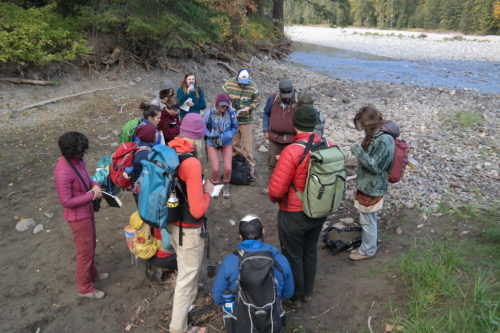
10:10 Scouler’s willow (Salix scouleriana), Brass buttons (Cotula cornopifolia), an unidentified purple petal Aster (Asteraceae), and unidentified purple petal Mint (Lamiaceae) were all observed. Brass buttons, Aster, and Mint were still in bloom and the area smells strongly of Mint. Common snowberry (Symphoricarpos albus) was in fruit and Douglass Fir (Pseudotsuga menziesii) were present in the forested area.
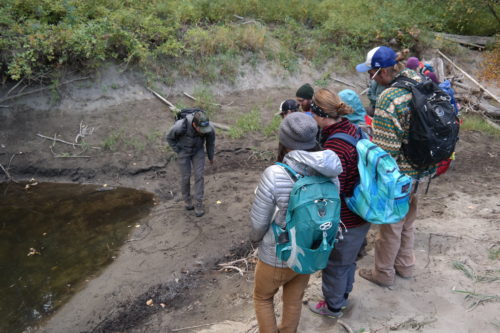
10:17 In a sandy river drainage, D. Moskowitz circled tracks for us to look at. The sand was holding on to moisture with pooling water in some areas. We took notes on gait, direction of travel and to think about who made this track. Charlee Corra and I examined a set of tacks, identifying them to be tracks from an ungulate.
10:25 D. Moskowitz discussed canine tracks, there is a distinctive “X” shape in between the pad and the toes. Canines have four, two-ranked toes. The shape of the pad is triangular. Domestic dog tracks are highly variable, but the tracks of a Gray wolf (Canis lupus) or a Coyote (Canis latrans) are going to be fairly consistent. All canine’s front paws are going to be larger than the hind paws, the hind paws will be narrower. D. Moskowitz told us to think about tracks from when they were made, not how we see them now. To think about how weather and water may or may not have changed them since then.
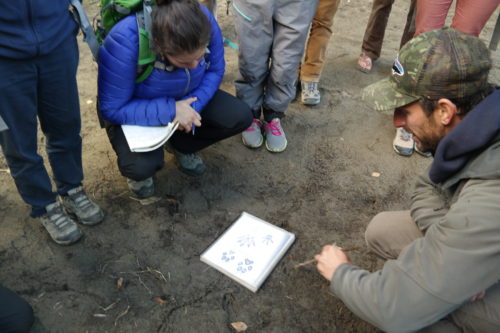
10:52 We look at Black bear tracks. D. Moskowitz found them not because they were easy to see, they were not, but because he knew what he was looking for. Comparing Mountain lion tracks to those of a Black bear. The toes of a Cougars are around the pad. Black bear toes sit above the pad. The sky began to clear, 50% stratus clouds breaking to the east, temperature 36 °F.
11:00 Deer track are observed; the dewclaws are visible. This feature will show up in soft, deep substrate or if the animal is running.
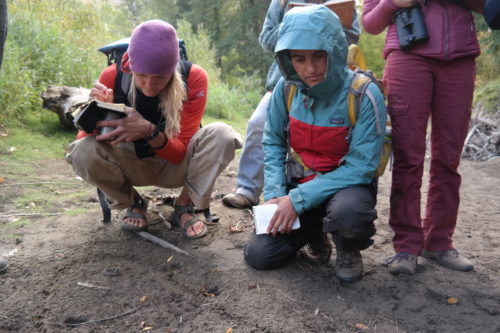
Zoe Wadkins and Gina Roberti closely examine tracks
11:05 We discuss the bank burrow that was created by a North American beaver (Castor canadensis). There are chewed pieces of wood around the burrow. This burrow has been abandon, bank burrows are used only when fully submerged to protect from predators.
11:04 Sun immerges through the cloud cover. Our group begins to bushwhack SW, past the American beaver burrow, into the forest. We move through Snowberry and downed trees.
11:14 D. Moskowitz points out a depression in the grass where an animal has laid down. The shape of the depression is bean like. There are some Deer tacks nearby. D. Moskowitz pulls out a Deer hair from the bed
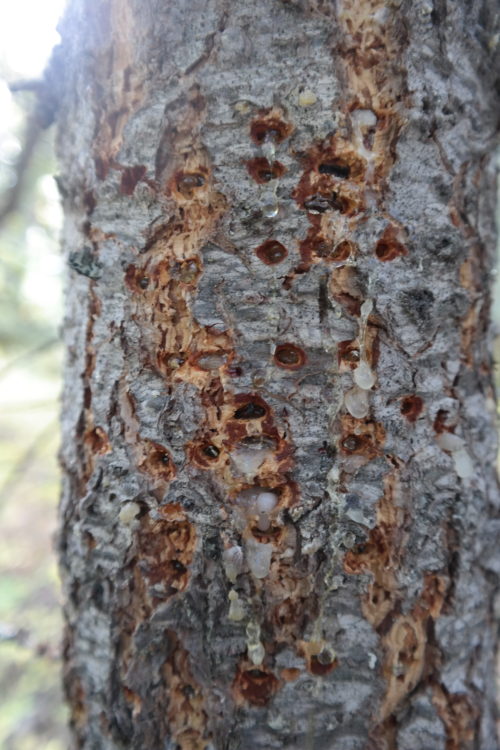
11:23 D. Moskowitz shows us square shaped shallow markings on a living tree. Most likely made by a Red-Napped sapsucker (Sphyrapicus nuchalis). Creating small neat rows in the tree, and lap up the sap that flows out. Insects are also interested in the sap and Sapsuckers will feed on these insects.
11:37 We move east. Great mullen (Verbascum thapsus), Ponderosa Pine (Pinus ponderosa) and Cascade Oregon Grape (Berberis nervosa) become present.
11:34 Crossed over a drainage via an abandon North American beaver dam.
11:39 D. Moskowitz points out another sleeping depression under a Western red cedar (Thuja plicata). There are claw marks 15 ft. up the tree, most likely made from a Black bear. Female bears will put their cubs in a tree while they feed. Clouds are beginning to disperse to a 30% stratus cover, 38 °F.
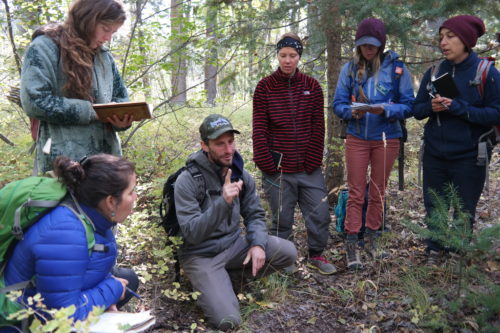
12:28 We break up into small group and to look for signs of wildlife and report back to the group.
12:15 Meet back up with the rest of the cohort to go look at our findings. Nate Trachte leads the group across the drainage to the west bank. N.Trachte points out Black bear tracks along the sandy bank. Based off the gait of the track we can tell the Black bear is walking, the hind foot lands beyond the front foot. The front foot has a thinner and wider pad and the back pad is larger and width.
12:30 Eric Buher showed us his found tracks, small tracks of 5 print sequences that traveled back and forth from the base of Black cottonwood roots to the felled debris. Each set of 5 tracks spanned a space of 1.5 in by 3.5 in. Upon group consultation, it is tracks of a Deer mouse (Peromyscus maniculatus) traveling between food source and the den.
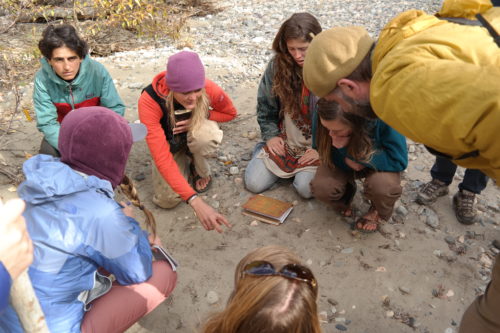
12:57 Zoe Wadkins leads us tracks that are located near the water and are 4 cm in length. Using D. Moskowitz tracking guide, we identified these to be an American mink (Neovison vison) tracks. Where the tracks are located, suggests that the large piled log jam is most likely the Mink’s den.
13:11 Kira Taylor-Hoar and I showed the group the tracks we found, those of a Moose (Alces alces). When the tracks were created, the ground was probably saturated, allowing the Moose to leave a track behind that was sunken in 2’’, the dewclaws were visible. Considering Washington had not received a significant amount of rain recently the tracks were probably created in the spring. Nearby the tracks we observed Black cottonwood branches that have been chewed at around chest height, probably a Moose. Accumulating cumulus layer approaching from the west covering 50% if the sky, sustaining winds of 5-10 knots from the southwest.
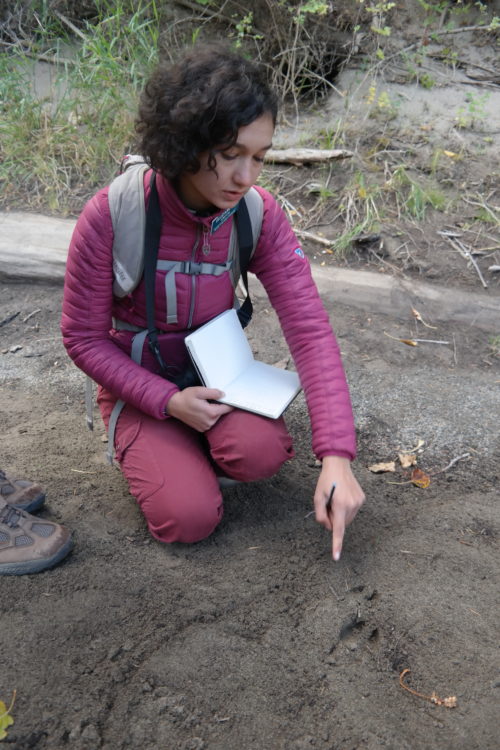
Liz Grewal points out the tracks of deer.
13:14 D. Moskowitz shows us Black bear scat, by taxonomy bears are carnivores but by feeding are omnivores. The vegetative matter that is consumed comes out similar to the form of how it was consumed. There was another scat that D. Moskowitz points out, of asymmetrical shape of plump pellets that are layered and flattened in shape. This shape and consistency of well digested pellets is indicative of Moose scat.
13:32 Ponderosa pine that D. Moskowitz lead us to a Ponderosa pine with the southwestern side empty of bark, the surface of the rub is consistent throughout. D. Moskowitz posed this question to the group, “What tool would you use to replicate this behavior?”. Our group decided on a wood rasp, base of ungulate antler resemble this tool. This rubbing behavior is associated with rut. Male ungulates have scent glands throughout their body. Females enter heat by induced estrus and need to sense the male pheromone to do so.
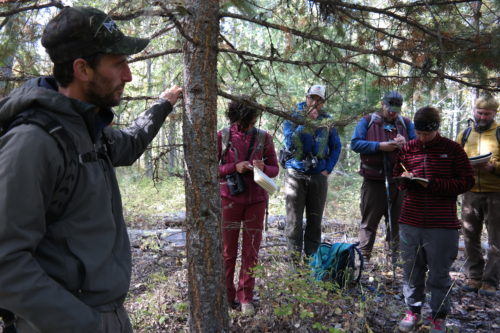
14:10 D. Moskowitz takes us to a Ponderosa pine that is well known to him as a scent marking location. We observed 2 distinct bare spots were identifiable both at shoulder and waist height. Deep claw marks could be seen along the northern facing side of the tree, and serrated tooth puncture marks on the southern facing side. D. Moskowitz explained that Black bears rub against trees to communicate with other bears that they are in the area and not as territorial markers. The ground surrounding the base of the tree has been stomped out.
14:58 2 Golden eagles (Aquila chrysaetos) soar in the north above the ridge line.
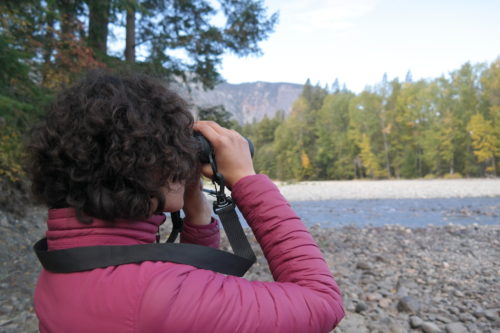
Liz Grewal uses her binoculars to identify Golden eagles above.
15:08 We loaded up on the bus and head back to the Environmental Learning Center. The darkening cumulus clouds returning 80% cover over the horizon, forecasting precipitation.

